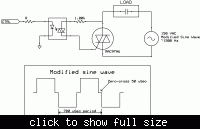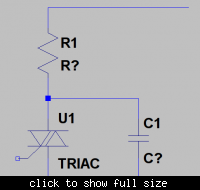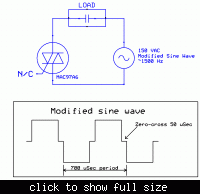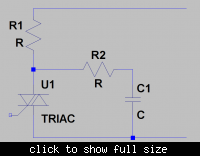AleXYZ
Junior Member level 3
This problem has had me pulling my hair out for 2 weeks now... it is wired up on my bench and can't find the right incantation to make it work!
How do I do TTL level switching of a high voltage A/C circuit with the modified sine wave as shown? Should I be using something other than a triac? Is the problem that the load is capacitive?

The TRIAC (MAC97A6) turns on at power-up and will not turn off.
The optoisolator is a MOC3023.
The load currents are very small, less than 20 milliamps.
I have tried different resistor values from 100 ohms to 10k ohms.
The AC power supply is microcontroller timed, and rendered by a dual MOSFET H-Bridge off a 150v DC rail.
If you have the right answer and live within 50 miles of me I will happily buy you a case of your favourite beer!
How do I do TTL level switching of a high voltage A/C circuit with the modified sine wave as shown? Should I be using something other than a triac? Is the problem that the load is capacitive?

The TRIAC (MAC97A6) turns on at power-up and will not turn off.
The optoisolator is a MOC3023.
The load currents are very small, less than 20 milliamps.
I have tried different resistor values from 100 ohms to 10k ohms.
The AC power supply is microcontroller timed, and rendered by a dual MOSFET H-Bridge off a 150v DC rail.
If you have the right answer and live within 50 miles of me I will happily buy you a case of your favourite beer!


